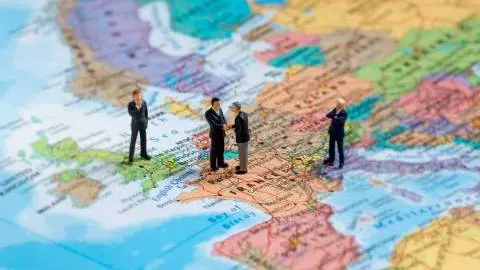Exploring new trade deals amid rising protectionism
Despite trade challenges and tariff threats, there are also some positive developments. The EU is actively pursuing new trade agreements, and nearly all African Union members have joined the African Continental Free Trade Area. The Trans-Pacific Partnership is also considering new applicants, with Costa Rica a likely candidate in the coming years
Despite all the doom and gloom about trade, there are some positive developments in the form of trade agreements. The EU has been actively pursuing new and renewed trade deals, while the African Continental Free Trade Area (AfCFTA) is progressing, with 54 out of 55 African Union members signing the agreement as of 2025. Similarly, the Comprehensive and Progressive Agreement for Trans-Pacific Partnership (CPTPP) is considering new applicants, with Costa Rica likely to join in the coming years.
EU strengthens global trade ties with new and renewed agreements
The EU has been particularly busy forging new trade deals or renewing old ones over the last couple of months, namely:
- EU-Mercosur: A new partnership between the EU and Mercosur (Argentina, Brazil, Paraguay, Uruguay). The European Commission is expected to submit proposals for Council decisions to sign and conclude the agreement by mid-2025.
- EU-Switzerland: Completion of negotiations on a broad package of agreements between the EU and Switzerland. The formal signing is scheduled for spring 2025, with Swiss parliamentary approval expected after 2025.
- EU-Mexico: Modernisation of the EU's Global Agreement with Mexico. Negotiations concluded on 17 January 2025. The modernised agreement will replace the current one once ratified.
- EU-Malaysia: Relaunch of an EU-Malaysia free trade agreement. Negotiations were relaunched on 20 January 2025, after being on hold since 2012.
- EU-Chile: The EU-Chile Interim Trade Agreement (ITA) came into force on 1 February 2025. It will be replaced by the Advanced Framework Agreement once all EU Member States complete their ratification processes.
But which of those agreements will be successful if implemented?
1) Already in force/few obstacles:
- EU-Chile and EU-Mexico: The former agreement has already entered into force as of 1 February 2025, while the modernised agreement between the EU and Mexico is expected to be ratified without major obstacles, as it builds on an existing framework.
2) Some obstacles:
- EU-Switzerland: While there is a strong economic incentive for both the EU and Switzerland to ratify these agreements – the agreements are intended to significantly facilitate trade once again, level the playing field for companies on both sides and allow Switzerland seamless access to the EU single market – there is opposition within Switzerland, reflecting concerns about Swiss sovereignty and the implications of closer ties with the EU.
3) Many obstacles:
- EU-Mercosur: The EU-Mercosur agreement has faced a long and complex negotiation process, spanning over 20 years. There are still significant concerns regarding environmental standards, deforestation, and adherence to the Paris Agreement, which is why EU member states, with France at the forefront, have expressed strong reservations, making the ratification process more uncertain. If the trade agreement is signed in its current form, i.e., a ‘mixed’ agreement including both trade and non-trade measures, it would necessitate approval from the European Parliament as well as all national parliaments. It would also require ratification by all 27 EU member states. While the EU can negotiate trade agreements on behalf of its members with a qualified majority, any agreement involving shared competence between the EU and its member countries must be ratified by each member state. Remember that the Canadian-European Trade Agreement (CETA) has not yet been ratified by all member states. This adds complexity and increases the chances of failure.
EU-Malaysia: The resumption of negotiations has just started, meaning a lengthy process will follow. Yet, restarting negotiations after a long hiatus indicates a renewed commitment from both sides.
Strengthening national security and securing critical raw materials
In addition to general trade agreements, several countries are actively working on securing critical raw materials to ensure a stable supply. These strategic minerals include:
- Lithium.
- Cobalt.
- Nickel.
- Rare earth elements.
- Graphite.
These minerals are essential for the green and digital transitions, supporting industries such as clean energy, digital technologies, defence, and aerospace.
European Commission initiatives
The European Commission has initiated several partnerships on critical raw materials to support the green and digital transitions. Following the Action Plan on Critical Raw Materials and the Critical Raw Materials Act, agreements have been signed with various countries over the years:
- 2021: Canada and Ukraine.
- 2022: Kazakhstan and Namibia.
- 2023: Argentina, Chile, Zambia, the Democratic Republic of Congo, and Greenland.
- 2024: Rwanda, Norway, Uzbekistan, and Australia.
Global efforts
- United States: The US has been working on securing critical minerals through partnerships and agreements, such as those with Australia and Canada. Additionally, the potential for a critical minerals agreement between the US and Ukraine highlights the lengths to which nations will go to secure valuable mineral resources.
- Japan: Japan has been actively securing critical raw materials through agreements with countries like Australia and Kazakhstan.
- Australia: As a major supplier of critical raw materials, Australia has signed agreements with countries like Japan, South Korea, and the United States to ensure a stable supply chain.
- China: China remains a dominant player in the critical raw materials market, controlling a significant share of the world's supply. Additionally, China has secured its supply chains through investments and partnerships in Africa and South America.
Download
Download article
5 March 2025
Trump, tariffs, and trade: our predictions for the coming months This bundle contains 3 ArticlesThis publication has been prepared by ING solely for information purposes irrespective of a particular user's means, financial situation or investment objectives. The information does not constitute investment recommendation, and nor is it investment, legal or tax advice or an offer or solicitation to purchase or sell any financial instrument. Read more
